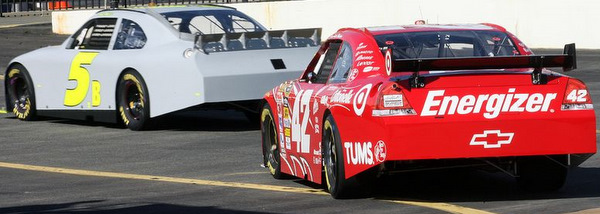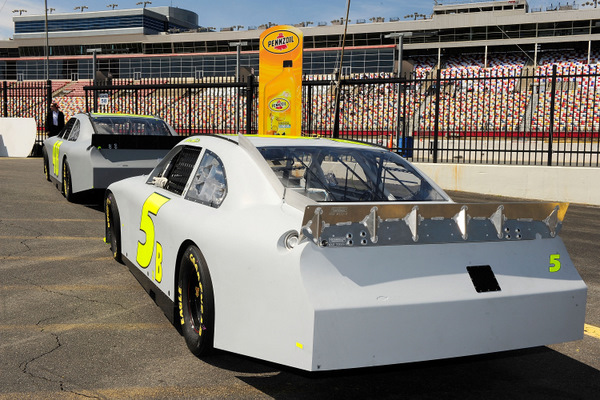NASCAR's Pemberton says Charlotte test is going smoothly, but has little to say about the issue of 'flying' race cars
Robin Pemberton, NASCAR's competition director, says he likes what he sees at Charlotte Motor Speedway....but doesn't have much to report on NASCAR's investigation of Brad Keselowski's airborne crash as Atlanta (Photo: Getty Images for NASCAR)
By Mike Mulhern
mikemulhern.net
CONCORD, N.C.
NASCAR's Robin Pemberton says the first downforce track test of NASCAR's new flat-blade rear spoiler is going very smoothly and he doesn't anticipate the need for any more such tests this season at mid-sized tracks like Charlotte Motor Speedway or at Daytona before the July Fourth weekend 400 either.
However Pemberton had no specific update on any possible solutions to the aerodynamic problem that got Brad Keselowski airborne at Atlanta two weeks ago.
"We're not quite done with our part of the investigation," Pemberton said. "Some of the things you see (here), with the larger fin on the deck and the back glass, are based on tests we've been doing, things that weren't in play at Atlanta.
"So we've already made adjustments post-Atlanta to help with the lift-off speeds.
"The testing and the investigation are on-going. When the investigation gets done and we're happy with our findings, the development will continue, to help the cars react and do things we need them to do on race day."
Some of the aerodynamic options NASCAR might be studying in the Keselowski situation are still apparently being kept under wraps, for some reason. Detroit engineers said Sunday that removing the left-side 'skirt' – that four-inch-tall piece of metal under the driver's door, designed to give the car more downforce, by keeping air from getting underneath it – could raise the lift-off speed of a car in Keselowski's situation from about 140 mph to nearly 180 mph. However that depends on which way the car might be spinning, clockwise or counterclockwise.
NASCAR apparently studied that option during a recent wind tunnel test at the Chrysler wind tunnel, a test to which the various car makers were invited. Just what else might have been studied at that test is still unclear, and Pemberton was not willing to go into many specifics: "I'll let you know when we come up with the next 'package.'"
Pemberton, however did dispute the 'left-side-skirt' issue, by saying the improvement in raising critical lift-off speed in a Keselowski-type crash might only be 18 to 20 mph, not the 40 mph.
"Still, that is significant," Pemberton agreed.

Juan Pablo Montoya's car, with the old wing, sitting behind Mark Martin's car with the new flat-blade spoiler, Tuesday at Charlotte Motor Speedway (Photo: Getty Images for NASCAR)
The reason for this week's testing is the pending switch from the rear wing, used in 93 Sprint Cup races over the past three years, to the old flat spoiler. The first race with the 'new' spoiler is this weekend at Martinsville, a slow-speed track; the first major tests of it will be at Phoenix and Texas in the coming weeks. (Of those 93 events, fully 46 races were won by only three drivers, Jimmie Johnson, Kyle Busch and Carl Edwards.)
So Pemberton called this two-day test "one of the most important tests these teams have had in the past two years.
"Looks like the test is going fairly well. We just made a gear adjustment, to give them more RPM, which they will like.
"All in all, it's been pretty straightforward and basic, single-car runs. As they get more comfortable, they'll start racing closer."
Pemberton expressed confidence in the teams' preparation for this test: "They show up at the track and they're 90 percent ready. Some teams here have only changed a couple of springs in five hours.
"And this track (asphalt) has a good surface; it's still new, so it's smooth and has good grip, so it's easy for their (computer-based) simulation work to match up."
Pemberton added that teams are so sophisticated now "they're beyond testing at a specific track (for a specific race).
"Before the testing ban, teams wouldn't really 'test,' they would practice for the upcoming race. The difference you see here today is because of the limited testing, they are going through a test matrix, where they can find things they can apply to different race tracks.
"The test issue will always be debated...and we continue to address it, and it's a very fluid policy."
Pemberton said NASCAR has decided to give teams restrictor plates next month at Talladega with holes 15/16ths of an inch in diameter, which is slightly smaller than what was tested there last week. The closing rate in the draft during that test was significant, and Dale Earnhardt Jr. said during one such run he hit 213 mph when closing in the draft.
Pemberton said he anticipated the new aerodynamic configuration being used here – the 4-1/2-inch-tall flat rear spoiler, 63 inches wide, and the 3-1/2 'shark-fin' rudder-type device on the left-side of the rear deck – would add 80 to 180 pounds of downforce.
That would be about a 10 percent increase in downforce, which should make the cars turn better in the corners.
And Pemberton said he had not seen any excessive tire wear here. "One of the teams just made a 40-lap (60-mile) run on tires, which is three-quarters of a fuel run, and there were no issues," Pemberton said.
However on the downside, the flat spoiler should create 'dirtier' air in a car's wake, which could revive the 'aero-push' issue that so many drivers griped about – that they could pull up on a leading car, but then hit a wall of dirty air and be unable to make a pass.
And there is always the risk of NASCAR teams getting hit by the law of unintended consequences.
"It's up to the teams to be prepared....and any rules change is going to have both negative and positive things on particular drivers and teams," Pemberton said. "It's important to them to get their cars right....because we throw the green flag and the checkered flag and then hand out the checks. However they want to get prepared for that, that's what they need to do. Right now the ball's in their court."
So why did NASCAR go with the wing in the first place?
"We had some reasons to go to the wing...and some of those might not have panned out. Quite frankly, one was the fact that nobody really warmed up to it. They didn't like it, they didn't like the appearance of it.
"They didn't embrace it.
"But fortunately we can do whatever we want, to address aero issues. So we decided to bring the spoiler back into play.
"It is something they will have to work toward, to get the handling packages correct, to get the cars to handle around other cars."
[Note: You can use Twitter as an easy headline service for mikemulhern.net stories, with our instant Tweets to your mobile as soon as our newest NASCAR story is filed. And mikemulhern.net is mobile-friendly for viewing. You can also use the orange RSS feed button as a quickie headline service on your laptop or home computer for mikemulhern.net stories, by creating a Live Bookmark RSS feed on your web browser's toolbar. Or you can create a Google Alert for mikemulhernnet.]

The new 'shark-fin' rudder-type stabilizing device is clearly seen here on the left side of Mark Martin's car (Photo: Getty Images for NASCAR)
© 2010-2011 www.mikemulhern.net All rights reserved.
Web site by www.webdesigncarolinas.com







Post new comment